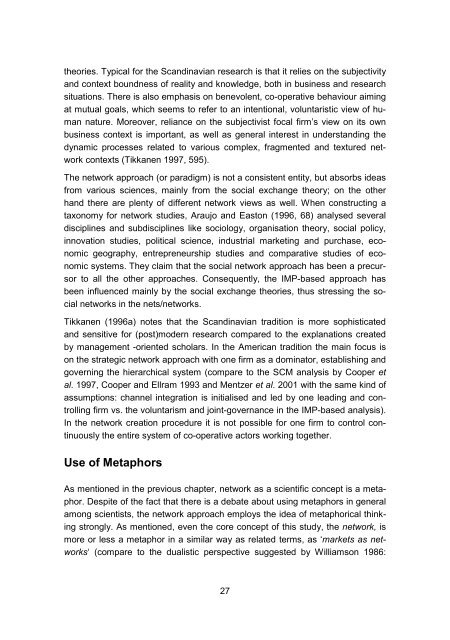849954 sisus
849954 sisus
849954 sisus
Create successful ePaper yourself
Turn your PDF publications into a flip-book with our unique Google optimized e-Paper software.
theories. Typical for the Scandinavian research is that it relies on the subjectivity<br />
and context boundness of reality and knowledge, both in business and research<br />
situations. There is also emphasis on benevolent, co-operative behaviour aiming<br />
at mutual goals, which seems to refer to an intentional, voluntaristic view of human<br />
nature. Moreover, reliance on the subjectivist focal firm’s view on its own<br />
business context is important, as well as general interest in understanding the<br />
dynamic processes related to various complex, fragmented and textured network<br />
contexts (Tikkanen 1997, 595).<br />
The network approach (or paradigm) is not a consistent entity, but absorbs ideas<br />
from various sciences, mainly from the social exchange theory; on the other<br />
hand there are plenty of different network views as well. When constructing a<br />
taxonomy for network studies, Araujo and Easton (1996, 68) analysed several<br />
disciplines and subdisciplines like sociology, organisation theory, social policy,<br />
innovation studies, political science, industrial marketing and purchase, economic<br />
geography, entrepreneurship studies and comparative studies of economic<br />
systems. They claim that the social network approach has been a precursor<br />
to all the other approaches. Consequently, the IMP-based approach has<br />
been influenced mainly by the social exchange theories, thus stressing the social<br />
networks in the nets/networks.<br />
Tikkanen (1996a) notes that the Scandinavian tradition is more sophisticated<br />
and sensitive for (post)modern research compared to the explanations created<br />
by management -oriented scholars. In the American tradition the main focus is<br />
on the strategic network approach with one firm as a dominator, establishing and<br />
governing the hierarchical system (compare to the SCM analysis by Cooper et<br />
al. 1997, Cooper and Ellram 1993 and Mentzer et al. 2001 with the same kind of<br />
assumptions: channel integration is initialised and led by one leading and controlling<br />
firm vs. the voluntarism and joint-governance in the IMP-based analysis).<br />
In the network creation procedure it is not possible for one firm to control continuously<br />
the entire system of co-operative actors working together.<br />
Use of Metaphors<br />
As mentioned in the previous chapter, network as a scientific concept is a metaphor.<br />
Despite of the fact that there is a debate about using metaphors in general<br />
among scientists, the network approach employs the idea of metaphorical thinking<br />
strongly. As mentioned, even the core concept of this study, the network, is<br />
more or less a metaphor in a similar way as related terms, as ‘markets as networks‘<br />
(compare to the dualistic perspective suggested by Williamson 1986:<br />
27








